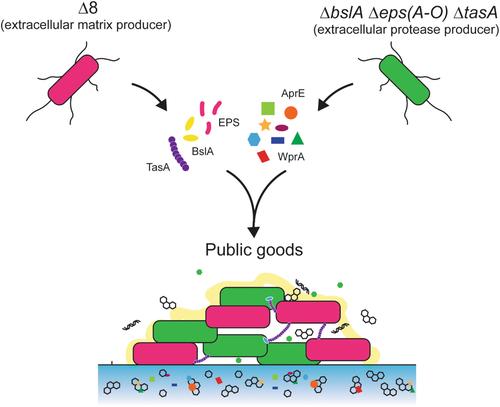当前位置:
X-MOL 学术
›
Mol. Microbiol.
›
论文详情
Our official English website, www.x-mol.net, welcomes your
feedback! (Note: you will need to create a separate account there.)
Reciprocal sharing of extracellular proteases and extracellular matrix molecules facilitates Bacillus subtilis biofilm formation
Molecular Microbiology ( IF 2.6 ) Pub Date : 2024-06-22 , DOI: 10.1111/mmi.15288 Thibault Rosazza 1 , Chris Earl 1 , Lukas Eigentler 1, 2 , Fordyce A Davidson 2 , Nicola R Stanley-Wall 1
Molecular Microbiology ( IF 2.6 ) Pub Date : 2024-06-22 , DOI: 10.1111/mmi.15288 Thibault Rosazza 1 , Chris Earl 1 , Lukas Eigentler 1, 2 , Fordyce A Davidson 2 , Nicola R Stanley-Wall 1
Affiliation

|
Extracellular proteases are a class of public good that support growth of Bacillus subtilis when nutrients are in a polymeric form. Bacillus subtilis biofilm matrix molecules are another class of public good that are needed for biofilm formation and are prone to exploitation. In this study, we investigated the role of extracellular proteases in B. subtilis biofilm formation and explored interactions between different public good producer strains across various conditions. We confirmed that extracellular proteases support biofilm formation even when glutamic acid provides a freely available nitrogen source. Removal of AprE from the NCIB 3610 secretome adversely affects colony biofilm architecture, while sole induction of WprA activity into an otherwise extracellular protease-free strain is sufficient to promote wrinkle development within the colony biofilm. We found that changing the nutrient source used to support growth affected B. subtilis biofilm structure, hydrophobicity and architecture. We propose that the different phenotypes observed may be due to increased protease dependency for growth when a polymorphic protein presents the sole nitrogen source. We however cannot exclude that the phenotypic changes are due to alternative matrix molecules being made. Co-culture of biofilm matrix and extracellular protease mutants can rescue biofilm structure, yet reliance on extracellular proteases for growth influences population coexistence dynamics. Our findings highlight the intricate interplay between these two classes of public goods, providing insights into microbial social dynamics during biofilm formation across different ecological niches.
中文翻译:

细胞外蛋白酶和细胞外基质分子的相互共享促进枯草芽孢杆菌生物膜的形成
细胞外蛋白酶是一类公共产品,当营养物质呈聚合形式时,它支持枯草芽孢杆菌的生长。枯草芽孢杆菌生物膜基质分子是生物膜形成所需的另一类公共物品,并且易于被利用。在这项研究中,我们研究了胞外蛋白酶在枯草芽孢杆菌生物膜形成中的作用,并探讨了不同条件下不同公益生产菌株之间的相互作用。我们证实,即使谷氨酸提供了可自由利用的氮源,细胞外蛋白酶也支持生物膜的形成。从 NCIB 3610 分泌组中去除 AprE 会对集落生物膜结构产生不利影响,而仅将 WprA 活性诱导到其他无细胞外蛋白酶的菌株中就足以促进集落生物膜内皱纹的形成。我们发现,改变用于支持生长的营养源会影响枯草芽孢杆菌生物膜的结构、疏水性和结构。我们认为,观察到的不同表型可能是由于当多态性蛋白质提供唯一氮源时生长对蛋白酶的依赖性增加所致。然而,我们不能排除表型变化是由于替代基质分子的产生所致。生物膜基质和细胞外蛋白酶突变体的共培养可以挽救生物膜结构,但对细胞外蛋白酶生长的依赖会影响群体共存动态。我们的研究结果强调了这两类公共产品之间错综复杂的相互作用,为不同生态位生物膜形成过程中的微生物社会动态提供了见解。
更新日期:2024-06-22
中文翻译:

细胞外蛋白酶和细胞外基质分子的相互共享促进枯草芽孢杆菌生物膜的形成
细胞外蛋白酶是一类公共产品,当营养物质呈聚合形式时,它支持枯草芽孢杆菌的生长。枯草芽孢杆菌生物膜基质分子是生物膜形成所需的另一类公共物品,并且易于被利用。在这项研究中,我们研究了胞外蛋白酶在枯草芽孢杆菌生物膜形成中的作用,并探讨了不同条件下不同公益生产菌株之间的相互作用。我们证实,即使谷氨酸提供了可自由利用的氮源,细胞外蛋白酶也支持生物膜的形成。从 NCIB 3610 分泌组中去除 AprE 会对集落生物膜结构产生不利影响,而仅将 WprA 活性诱导到其他无细胞外蛋白酶的菌株中就足以促进集落生物膜内皱纹的形成。我们发现,改变用于支持生长的营养源会影响枯草芽孢杆菌生物膜的结构、疏水性和结构。我们认为,观察到的不同表型可能是由于当多态性蛋白质提供唯一氮源时生长对蛋白酶的依赖性增加所致。然而,我们不能排除表型变化是由于替代基质分子的产生所致。生物膜基质和细胞外蛋白酶突变体的共培养可以挽救生物膜结构,但对细胞外蛋白酶生长的依赖会影响群体共存动态。我们的研究结果强调了这两类公共产品之间错综复杂的相互作用,为不同生态位生物膜形成过程中的微生物社会动态提供了见解。






























 京公网安备 11010802027423号
京公网安备 11010802027423号